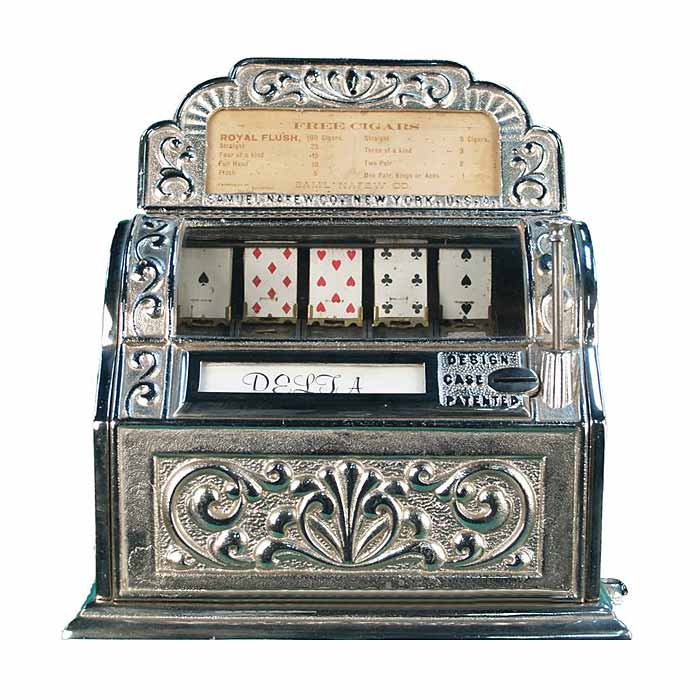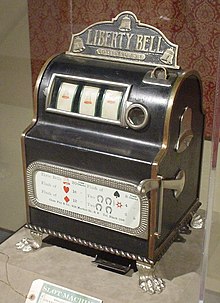First Slot Machine In The World
Everyone knows how a slot machine works. You put your money in, pull the lever and hope that the reels match up for the big payout. What you may not know is that the history of slot machines is fascinating and shows just where they’re headed in the future.
The Origin of Slot Machines


The term “slot machine” originally referred to standard vending machines when it was first coined back in the 1880s. The name comes from dropping a nickel into the coin slot to get the product you wanted.
Which slot machine games are hot right now? This article takes you through 10 world’s famous slot machines games - Starburst, Gonzo’s Quest, Jumanji, and more. The first mechanical slot machine was the Liberty Bell, invented in 1895 by car mechanic, Charles Fey (1862–1944) of San Francisco. The Liberty Bell slot machine had three spinning reels. Diamond, spade, and heart symbols were painted around each reel, plus the image of a cracked Liberty Bell.
By 1885, the first machines designed for gambling were created, but they bore little resemblance to what we call a slot machine today. These were novelty machines that featured things like toy horses racing around a small track, and patrons of bars and saloons would often bet nickels or tokens that could be redeemed for drinks and cigars.
In 1891 a Brooklyn establishment developed a machine that was closer to what we know today. This machine had five drums, and each drum had 10 different card faces on it, which made it a primitive slot poker machine. Like before, people would put nickels in and get drinks or cigars as prizes based on the hands they won. The 10 of spades and jack of hearts were not included on most machines, which made it harder for people to get a royal flush. A big problem, however, was that automatic payouts were impossible due to a large amount of winning combinations.
History of Slot Machines at the Turn of the 1900s
Finally, in 1894-5, a Bavarian-born San Franciscan named Charles Fey created the “Liberty Bell”, the first true slot machine. This used three spinning reels with five symbols on each. These symbols were the eponymous bells, hearts, spades, diamonds, and horseshoes. The simpler and smaller method allowed automatic payouts of actual cash, and three bells produced the biggest payout of 50 cents. Over 100 of these machines were made, but only four survive today due to the 1906 earthquake and subsequent fire.
Competitors quickly refined the original design. By 1909, they were finding ways to circumvent the bans on slot machines that were being imposed by many states and cities. The card suits were replaced with the now-ubiquitous fruits, and anyone who got three like fruits would win some chewing gum of that flavor.
Most of these early “chewing gum dispensers” didn’t have slots for nickels, and the financial transactions were done over the bar itself. They did, in time, have slots for ejecting chewing gum. The “bar” symbol was developed in 1910, and it was originally a variation on the logo of the Bell-Fruit Gum Company. In 1916, the first true jackpot originated when the Mills Novelty Company developed a way to regurgitate all the machine’s coins with certain reel combinations.
By 1920, however, many states caught on, and even these machines were banned. In 1931, gambling was legalized in Nevada, and slot machines quickly became a top method of making money. By 1951, Nevada was the only state that had legal slot machines, but other states and other countries started having changes of heart because of the amount of money that could be made.
By 1963, the first fully electromechanical slot machine, “Money Honey”, had been invented. This allowed things such as bottomless coin hoppers, automatic payouts of up to 500 coins, and 3- or 5-coin multipliers, allowing extra ways to play and win. In 1976, the first true all-video machines were created, where people could just press a button.
In 1986, the method of linking multiple machines of the same type was developed, allowing higher super jackpots linked to anyone playing on those machines. Improvements in computer technology and random number generation have led to the slots we love today.
Why Are Slots So Popular?
First, they’re designed to make the player seem like they have more control over the game. This is despite the fact that they actually have less control over how they fare than they would with anything else in a casino. There’s no dealer involved, no other players and no one standing by to remind you of what you have to do. There’s just you and the machine.
Second, they’re designed for people to have fun. Unlike card games, which involve a lot of pressure, psychology and personal skill to win, the only thing you have to do is pull the lever or press the button to enjoy the sounds and pictures. If you do manage to win a good amount, you are greeted with bright lights and virtual confetti on top of your winnings.
Third, they’re designed to bring out all of our ideas about luck. Since they are computerized to ensure a completely random outcome, we get to see if crossing our fingers or holding that rabbit’s foot actually means something.
What the Future Holds for Slot Machines
The technology continues to evolve and adapt to new trends in gaming. Millennials are less likely to use slot machines than their elders because they prefer skill to sheer luck. To solve this problem, new skill-based machines are being developed.
As sports betting is expanding, another concept being reviewed is a combination betting machine that would allow players to bet on sports and slots at the same time. Voice controls are also on the horizon for many slot machine manufacturers, and so are machines that accept cryptocurrencies such as Bitcoin.
Who Was Charles Fey?
Charles Fey is arguably one of the greatest names in the cycles of gambling, credited as the person behind the invention of the slot machine. The slot machine brought about a revolution in the gambling world, a sensation that up to date, continues to be an integral part of gaming. Charles Fey is the brainchild behind the slot machine, bringing about the thrill and exhilarating experience that got many people onboard of the gaming cruise.
Name Of First Slot Machine

Charles Fey was born into an incredibly large family, surrounded by his 15 siblings. Fey, born in Bavaria, was never projected to become an inventor in the future as he grew up. His formative years featured helping out his family. As he grew up, Fey dreaded being drafted into the German Army and had differences with his father. Charles Fey focused his attention and energy into the art of instrument making, a trade that he performed quite flawlessly.
At the age of 23, Charles Fey joined his uncle in the United States, where he had numerous opportunities to advance his career. It was while working at Electric Works that he, together with a co-worker broke links with the employer and came up with a rival company. The invention that put Charles Fey into the history books happened while he was working at his company.
Features Of Fey’s Great Invention
Charles Fey slot machine was more straightforward in functionality and appearance as compared to the currently existing slot gaming machines.
The features of the very first slot machine included three revolving reels. The symbols appearing on the machine featured the more common card symbols like the diamond, spade, and hearts. Other symbols included horseshoes and a majestic Liberty Bell, which gave rise to the machine’s name.
The game’s symbols and outlay were quite easy, and a win was easy to decipher. Lining up three Liberty Bell’s symbols on the reels granted the player the game’s ultimate payout. The automatic payout feature of the game was the standout feature, something unheard of in those days. The massive success following the release of the game saw many imitations of the same arise within a short period.
Mills Slot Machine History
With stringent laws, many against Charles Fey slot machine invention, the inventor could not patent his slot machine, prompting him to rent them out to various entertainment joints. Over time, to counter emerging cheating trends relating to his invention, Charles Fey made some alterations to the machine, including the world’s first-ever detecting pin. Fey perfected his slot machine invention for the period between 1887 and 1895.
The Beginning Of Greatness
Powered and influenced by the great success that his slot machine achieved, Charles Fey, in 1896, established the Slot Machine Factory, one of its kind at the time. The factory set the precedent of massive success and influence of slot machines in the gambling industry.
Charles Fey’s immense influence on the gambling gaming scene is quite remarkable. Although his slot machine is no longer in use, having been overtaken by events and time, Fey’s invention was a game-changer. His original slot machine, known as the Liberty Bell, is currently on display in a museum in Reno. The great inventor died of pneumonia at the prime age of 82, having lived a thrilling life that inspired many people around the world.
The Wrap-Up
The Liberty Bell set the stage for the invention of better, more advanced, and more captivating slot machines. Many of the current existing slot machines including many titles in the online slots library have a relation to Charles Fey’s first slot machine, which was the basis of everything.
Play Free Real Slot Machines
Charles Fey’s influence on the gambling industry by inventing the world’s the first slot machine, the Liberty Bell, is palpable and vital. Many gamers today enjoying a slot machine game might take it for granted, but Charles Fey deserves a lot of credit, if not all. In as much as the current slot machine have little in common with the original version of the game, his invention set the stage for new heights in the gaming industry.